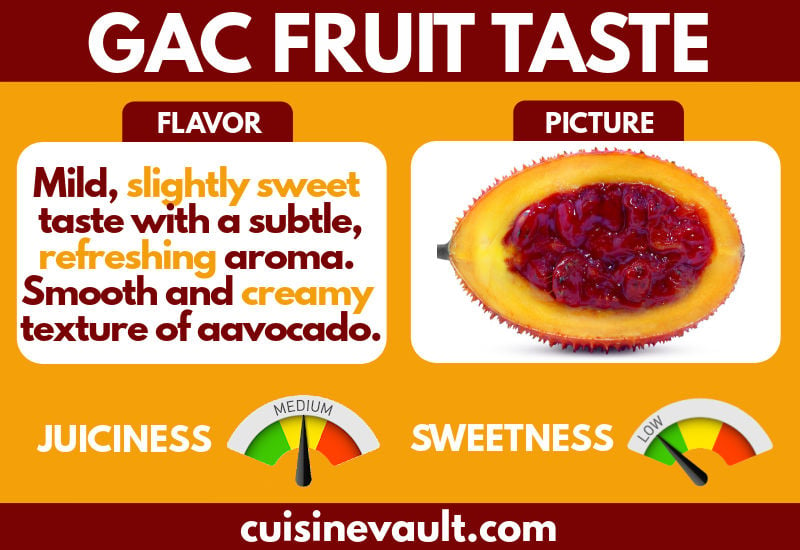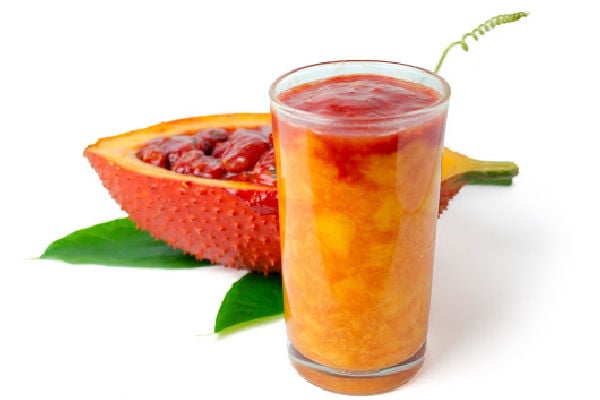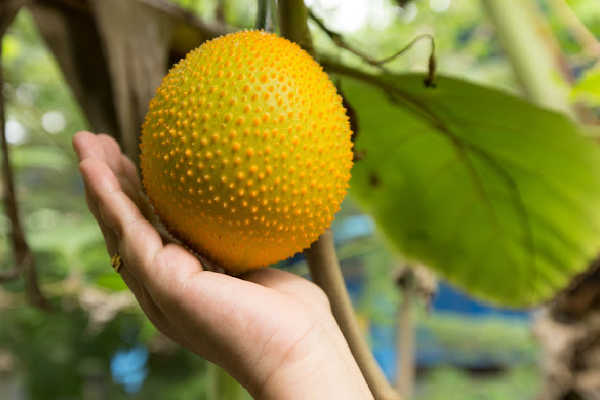The gac fruit is a small melon that is packed with lycopene and beta-carotene. It’s unlikely you’ve ever stumbled onto one if you live outside of Asia, so if you’d like to know what a gac fruit tastes like, then keep reading. We have all the details on its flavor, texture, and uses in the kitchen.
What do gac fruits taste like?
The gac fruit has a mild, slightly sweet taste and a molasses undertone. It has a subtle, refreshing aroma that is similar to a squash or cucumber. The fruit’s texture is smooth and creamy like an avocado. Once cooked, it develops a more dominant tomato-like flavor thanks to its high levels of lycopene.
Many popular tropical fruits, such as bananas or mangoes, have easily accessible flesh. The gac fruit is a much bigger challenge. Its vibrant red pulp surrounds large seeds and separating the two is messy and tedious. The easiest method is scraping it off the seeds by hand, but it may take half an hour to prepare a small bowl of fruit.
There is also a ½” layer of spongy, light orange flesh called the mesocarp. It lies under the skin surrounding the arils. This part of the fruit is edible but is usually discarded.
While the seeds aren’t poisonous, in most cases they are removed without eating. Their health benefits make them more commonly used in traditional Chinese medicine.
 Is the gac fruit worth your money?
Is the gac fruit worth your money?
The gac fruit isn't the type of ingredient most people would buy for a fresh fruit snack. Although it doesn't have any offensive sour, bitter flavor, or pungent aromas, it lacks the characteristics many people look for in a fruit. For example, there's very little sweetness, flavor, or satisfying juice, and getting to the flesh is hard work.
Although you may not eat one of these fruits out of hand, they still have their place in the kitchen. Gacs are an essential ingredient in Vietnamese cuisine and have an important role to play in making xôi gấc. This dish uses the fruit to turn sticky rice into a red shade - an impressive looking meal for weddings or other special occasions like Vietnamese New Year.
Did you know? The color red is associated with good luck in Vietnam.
Related reading:
Do Blue Javas taste okay?
What does a coco de mer taste like?
What does a pineberry taste like?
How do cashew apples taste?
Other uses for gac fruits
Sauce
The fruit can be blended with tomato sauce or paste to create a sauce for pizza or pasta that carries additional health benefits. The slightly sweet, mild taste won't create any awkward flavors for your next Italian dish.
Curry
It is used for savory applications in countries like Sri Lanka. Adding the flesh to curries and then slow-cooking it draws out delicious tomato flavor and natural color.
Desserts
Use in desserts such as baked goods for adding color. In Thailand, it is commonly served with ice cream.
Powder
The fruit can be dried and ground into a powder, then added to beverages like tea and coffee or smoothies. It is also suitable for sprinkling onto food like salads, mostly for nutritional purposes.
Juices
The subtle taste and unique color of gac fruits also make them useful in juices. The fruit complements other ingredients well and street vendors in Asia will usually blend them with other sweeter, more flavorsome fruits before selling.

Gac fruit juice is excellent blended with other tropical fruits.
How to eat a gac
To open a gac, use a sharp knife to slice the fruit in half lengthways. Inside, you’ll discover brightly colored arils that can be scooped out with a spoon or your fingers. The pulp can then be scraped off the seeds and used in savory and sweet applications.
Nutrition
The gac is considered a superfood and, like other fruit that have a red or orange color, is packed with antioxidants and other nutritional benefits.
The flesh is high in carotenoids like beta-carotene and lycopene. You get up to 70 times the amount of lycopene from a gac fruit than you'd get from a tomato.
The fruit is also high in fatty acids, vitamin C, fiber, and zeaxanthin.
Where can you buy a gac?
The gac fruit is soft and easily damages so it is not ideal for transporting long distances. You're unlikely to find them fresh outside of Southeast Asia and some other tropical parts of the world.
Your best option is to try these fruits if you're traveling through countries like Vietnam or Thailand. Alternatively, try Miami Fruit or similar online fruit vendors if you live in the United States - they have an excellent shipping service which delivers to most parts of the country.
Fast facts about gacs
- Other names for this fruit include baby jackfruit, Quá Guc, sweet gourd, spiny bitter gourd, and cochinchin gourd.
- Their sugar content is relatively low, somewhere between that of a lemon and a strawberry.
- The fruit grows on dioecious vines which are often found on lattices of homes in warm climates.
- The gac fruit is also known as gac; its botanical name is Momordica cochinchinensis and is a part of the Cucurbitaceae (melon) family.
- It grows to the size of a small melon, starting green and developing into a bright orange rind that’s spiny.
- The fruit has a limited harvest which lasts for two months in December and January.
 Summing up
Summing up
The gac fruit grows throughout Southeast Asian countries and is popular in Vietnam, more for its color and health benefits, than its flavor.
It contains a mild, slightly sweet pulp that is unlikely to appeal to those looking for a new favorite tropical fruit. However, it does have its use in cooking, including xôi gấc, a popular Vietnamese dish.
We’d recommend giving this fruit a try if you're interested, but don't expect too much from it. Our experience from tasting the gac was okay, but nothing to write home about.
Are you considering growing a gac plant at home or have you found the fruit for sale at a market or restaurant? Please let us know in the comments below.

Leave a Reply